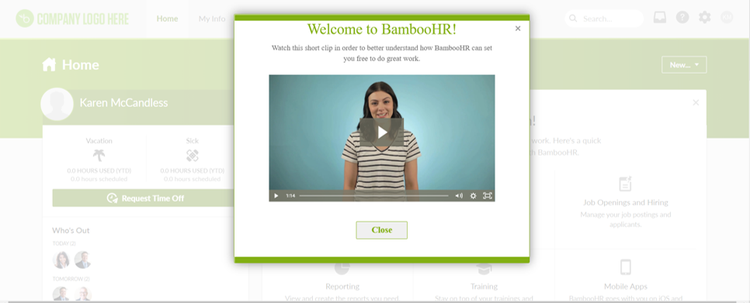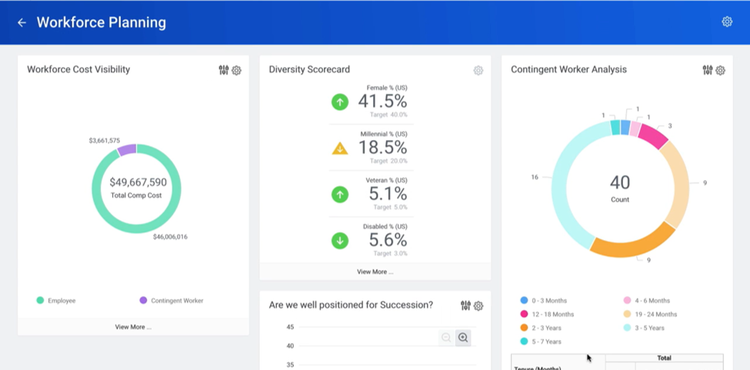Gone are the days of people staying with the same company all their lives.
With increased mobility and the fast pace of technological innovation, people have more choice than ever about where they work and who they work for. This means competition for highly-skilled workers is fierce. You can’t expect top talent to want to work for your company, and stay there for many years, unless you provide something in return.
The tables have turned. You need to focus on what you can do for your employees, not just what they can do for you. Part of that is understanding the importance of human capital management.
Showing you value your employees is a crucial way of creating a loyal, productive, and committed workforce.
Overview: What is human capital management?
Human capital management refers to the process of managing people, and the related processes and tools.
Areas that fall within the realm of human capital management services include:
- Recruitment and talent acquisition
- Onboarding
- Talent management
- Employee retention and satisfaction
- Performance management
- Training and development
- Wellness
- Benefits administration
- Offboarding
Benefits of effective human capital management
In the past, human capital management leaders were not given a seat at the executive table.
Now, with C-suite HR-based job titles such as Chief People Officer emerging onto the scene, businesses are waking up to the value that managing people processes has for a business.
Improve the recruitment process
Trying to hire employees without a process in place is not only expensive, time-consuming, and ineffective when it comes to finding the right person for the job, it also provides a poor candidate experience.
If you reschedule meetings, forget to reply to candidates, make them jump through unnecessary hoops and generally treat them with a lack of respect, then they are unlikely to want to work at your company. The top talent in the market will drop out before you’ve finished the process and it reflects badly on your company.
That’s why you need the right human capital management tools and processes to ensure you can recruit the best people for the job.
Boost employee satisfaction
Your people are the bedrock of your company. And, if you have shaky foundations, you won’t be able to build a strong and effective business. That’s why you need to have effective processes in place for managing human capital, i.e., your people.
When you take the time to get to know employees, to understand their needs and what they are looking for in a career, not just a job, at your company, then you’ll end up with a happier, more productive workforce. This could be through regular performance management, continuous learning and development, and improved benefits administration.
Making sure you are tuned in to your employees’ needs will boost satisfaction and ensure they stick around for the long haul.
Better serve clients
Whether your employees are in customer-facing roles, or even if they work in the back office, they all work with your clients in some way. This could be the back-end developer who has to fix a glitch in your website (or your client’s website), or the office manager who greets clients when the receptionist is off sick or on vacation, or the accountant who has to ensure bills are paid and invoices are sent.
When you manage your employees properly, you make sure they understand their role, and you give them the tools they need to better serve your clients.
If you don’t give enough vacation days and you notice people are starting to get sick and less productive, then it’s your job to take action to remedy the situation. If there’s a conflict between employees, you need to help mediate so this doesn’t spill over into client meetings.
Enhance communication
Human capital management often involves being the glue that holds the company together and the link between different departments. When you’re doing your job correctly, information should flow seamlessly between different departments and communication should be relatively easy.
While there will always be chat around the water cooler, or today’s virtual water coolers like Slack, you can minimize the need for gossip by sharing company news in a timely manner and giving regular updates on ongoing projects or changes.
Challenges of human capital management
If you work in human capital management, you have your fingers in many pies and have to make sure you can effectively keep up with all the different elements of your job. It’s tough, which is why you should seek help from your legal advisors and HR software provider when necessary.
Out-of-date tools
If you’re still using pen and paper or Excel spreadsheets to manage your workforce, then you’re more likely to make errors.
These could range from something minor like spelling someone’s name wrong to inputting the wrong numbers on an employment contract or making mistakes that mean you failed to comply with the relevant laws. You’ll also be inefficient and ineffective, and everything will take a lot longer.
That’s why you need to invest in human capital management software. Modern solutions are easy to use, intuitive, and you can get up and running in no time. They also come with reasonable price tags, and some are even free.
Staying compliant
As governments come and go, so do the laws that govern human capital management processes. One minute there is a change in the overtime pay law, the next, it’s been repealed. There’s an ongoing battle with the Affordable Care Act, which HR professionals need to keep their eyes on, so they can ensure they provide health insurance and benefits in line with the current legislation. These laws vary on a state-by-state basis.
Take at-will employment. Every state has its unique conditions and terms for this type of employment contract. Then you get laws introduced in other parts of the world, such as GDPR, that affect your business and require extensive research.
If you’re struggling to keep up, then you can either seek legal advice or ask for help from your HR software provider. Many businesses face the same issues, and you can benefit from their expertise and experience of working with other companies in the same position.
Measuring results
One reason why the HR department failed to get the respect it deserved in the past is because people couldn’t see the results it contributed to the business. HR professionals also had to make decisions based on gut feeling rather than concrete data. The department was then seen as a cost center rather than a profit center, as it didn’t contribute to business development.
One of the reasons for this was their inability to measure results. Now, through the use of HR analytics, also known as workforce analytics and people analytics, you can show the reasoning behind the decision and track the results of your action.
By measuring key HR metrics, such as company and department goals, absences, training progression, and time-to-hire, you can start to optimize the way you work, and proactively make decisions based on up-to-date information.
Best HR software for streamlining human capital management
To overcome the challenges you face as a human capital management professional, you should consider implementing HR software. You can automate manual tasks, streamline processes, and get the insight you need to make more informed decisions. Here are our picks of the best human capital management systems for your business.
1. Zenefits
Human capital management can feel a lot like spinning plates, hoping that none of them come crashing to the ground. There is such a diverse set of tasks and processes involved. That’s why you need a human capital management system that can help you manage all the different processes in one place.
Zenefits has functionality for:
- Recruiting
- Onboarding
- Absence and leave management
- Time tracking
- Benefits administration
- Payroll
- Performance management
- Wellness
- Compensation management
It’s a one-stop shop for getting the overview you need into your people and your processes.

Zenefits is one of the only leading HR solutions to include wellness functionality. Image source: Author
2. BambooHR
You’re pressed for time. You have a million things to do. You don’t have time to implement new software, migrate your data, learn how to use the system, and make sure everyone else in the HR department is up to speed.
BambooHR is a modern and intuitive HR solution that you can start using immediately without a manual. It’s well-organized, easy to navigate, and it’s user friendly. It also has a ton of resources to walk you through the features.

BambooHR provides resources to help you get up and running quickly. Image source: Author
Yes, it’ll take a bit of extra time to set it up, but in the long run, you’ll benefit from better data, improved decision making, smoother processes, and happier employees.
3. Workday
If your business is expanding, you need HR software that can grow with you and incorporate the extra demands of managing a bigger workforce. Workday helps you streamline your processes and enables your HR department to become more efficient and effective, and at scale.
Whatever the needs of your business, whether you have to hire contract employees to plug skills gaps, or keep track of diversity and pay equality, Workday has the functionality to help you thrive.
Crucially, Workday’s people analytics functionality provides in-depth insight into the performance of both employees and the business as a whole. This helps the HR department take a vital role in overall business strategy and resource management.

Workday’s reports give you insight into how your company is performing. Image source: Author
Take a people-first approach
All businesses have their own unique needs and ways of doing things. But all businesses have one thing in common: their people are their most important asset (and will remain so until the robots take over).
In the past, there was often a lack of respect for and investment in the HR department but now, as companies continue to wake up to the power of their employees, human capital management is becoming a crucial component of any company.
To be competitive, you need to invest in making sure that you have the tools, processes, data, and skills to enable success.
Our Small Business Expert
We're firm believers in the Golden Rule, which is why editorial opinions are ours alone and have not been previously reviewed, approved, or endorsed by included advertisers. The Ascent does not cover all offers on the market. Editorial content from The Ascent is separate from The Motley Fool editorial content and is created by a different analyst team.